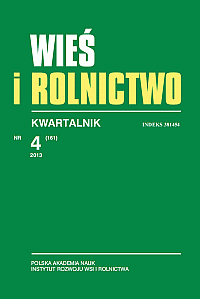Zagospodarowanie ziemi rolniczej w Polsce w okresie przed- i poakcesyjnym w ujęciu regionalnym
The regional dimension of agricultural land development in Poland in pre- and post-accession periods
Author(s): Wiesław Musiał, Włodzimierz DzunSubject(s): Economy
Published by: Instytut Rozwoju Wsi i Rolnictwa Polskiej Akademii Nauk
Keywords: economy of agricultural land; agrarian changes; gospodarka ziemią rolniczą; przemiany agrarne
Summary/Abstract: The paper discusses the problems of agricultural land use changes in Poland in the period between 1990–2012. Research shows large differences between the dynamics of the loss of these resources and the dynamics of their loss on agricultural holdings. In this period the area under agricultural production decreased by 0.7 million hectares, while the area in use as farms fell by about 3.2 million ha. At the same time showed farms strong growth in their area of agricultural land, which had little or no agricultural activity. Progressing at a pace is the process taking agricultural land out of production. With Polish agriculture under the CAP of the EU, and due, in particular, to the introduction of area payments, the process had slowed down significantly. However, with a lack of improvement in the profitability of agricultural production and increasing income opportunities outside of agriculture the process in recent years has clearly been revived. The scale and dynamics of these processes is strongly regionally differentiated. Research indicates that the smallest decline in area of agricultural land resource and the smallest scale not using these resources are attributed to Provinces with a favourable agrarian infrastructure and good agricultural practices, for example in the Provinces of Kujawy Pomosrskie (Pomerania), Greater Poland, Opole, and Podlaskie. At the other extreme, there are the Province with large agrarian fragmentation, i.e. Podkarpackie, Małopolska, Swietokrzyskie and Silesia . The scale of the process clearly inhibits opportunities for improvement of the agrarian structure and indicates a lack of instruments in agricultural policy to limit this. W opracowaniu podjęto problem zmian zachodzących w użytkowaniu ziemi rolniczej w Polsce w latach 1990–2012. Badania wskazują na duże różnice między dynamiką ubytku tych zasobów a dynamiką ich ubytku w użytkowaniu gospodarstw rolnych. W omawianym okresie powierzchnia użytków rolnych zmniejszyła się o 0,7 mln ha, podczas gdy ich powierzchnia w użytkowaniu gospodarstw rolnych – o 3,2 mln ha. Jednocześnie w gospodarstwach zdecydowanie wzrasta powierzchnia użytków rolnych, na której w ogóle nie prowadzi się żadnej działalności rolniczej lub tylko prowadzi się ją w ograniczonej skali. W szybkim tempie postępuje więc proces deproduktywizacji ziemi rolniczej. Objęcie polskiego rolnictwa WPR UE, a w szczególności wprowadzenie dopłat obszarowych, proces ten znacząco wyhamowało. Jednak brak poprawy w rentowności produkcji rolnej, przy wzroście możliwości uzyskania dochodów spoza rolnictwa, proces ten w ostatnich latach wyraźnie ożywiło. Skala i dynamika zmian omawianych procesów jest silnie zróżnicowana regionalnie. Badania wskazują, że najmniejszym spadkiem powierzchni zasobów ziemi rolnej oraz najmniejszą skalą deproduktywizacji tych zasobów charakteryzują się województwa o korzystnej strukturze agrarnej i o wysokiej kulturze rolnej, tj. kujawsko-pomorskie, wielkopolskie, opolskie, a także podlaskie
Journal: Wieś i Rolnictwo
- Issue Year: 161/2013
- Issue No: 4
- Page Range: 62-78
- Page Count: 17
- Language: Polish

